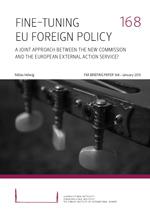The new EU leadership has restructured the way the European Commission manages its external relations. The High Representative/Vice-President, Federica Mogherini, was formally put in charge of coordinating the work of the Commissioners’ Group on External Action and relocated her offices to the Commission building.
Under the new approach, the Commission aims to be more closely involved in the preparation of Foreign Affairs Council meetings. Regular meetings of external action Commissioners are supposed to foster a common position, as well as increase the Commission input on sectoral policies and instruments ahead of ministerial meetings.
In the face of the gravitational shift towards the Commission, it is in the interests of member states to ensure that the EEAS remains, despite all its teething troubles, the political hub of EU external relations, and to invest in its development accordingly.
An in-depth examination of the externally relevant policies within the remit of the Commission reveals that, across all issues, EU foreign policy can improve by a joint approach combining the political perspective of the EEAS with the sectoral expertise of the Commission.


